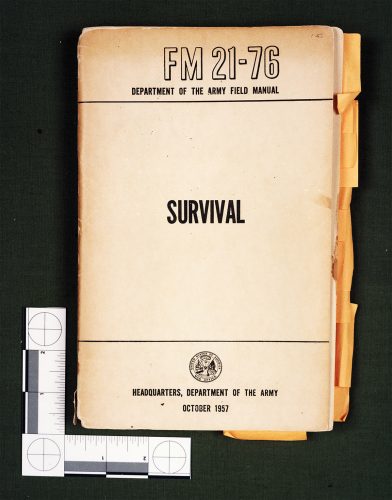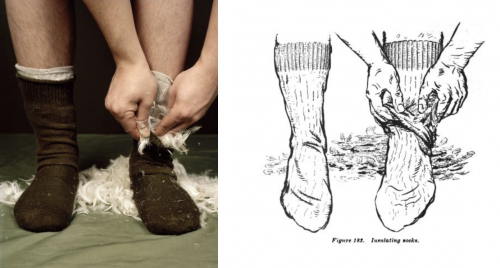Army Survival Art Inspires Project
Subjects of 1957 Army drawings find new life in Nicholas Bontrager’s work.
Army Survival Art Inspires Project
Subjects of 1957 Army drawings find new life in Nicholas Bontrager’s work.
One day in 2009, Nicholas Bontrager pulled a 1957 edition of Department of the Army Field Manual 21-76 from a bookstore shelf. Its pages sparked an idea that merged two of his passions: the use of graphics and text as teaching tools, and the preservation of those tools with replicas or facsimiles.

Nick Bontrager collected military artifacts, including a sign-painting kit, for his “Survival” project. Photo by Robert W. Hart
The manual is one of many guides printed by the U.S. Army for its soldiers and “covers everything from how to make a fish trap to what kind of plants you can eat, to wayfinding and navigating,” said Bontrager, associate professor of art who specializes in new media. What really caught his eye were the “sharp, clean line drawings” and the “gorgeous illustrations.”
Since then, Bontrager has been using older film cameras — a Calumet 4×5 and a Mamiya C33 twin-lens reflex — to re-create some of the illustrations on film for his “Survival” project. He also uses period objects in his photos for the sake of authenticity. A re-creation of insulating socks required a trip to an Army surplus store, where he “found the same type of sock that would have been issued during the Korean War.”

A pragmatic 1957 U.S. Army survival manual inspired 25 new illustrations by Nicholas Bontrager, associate professor of art. Courtesy of Nicholas Bontrager
For an illustration of a raft made from gas cans, the professor repaired and repainted gas cans from the 1950s. In subsequent updates the text is similar, but “the Army replaced a lot of those drawings with photos,” Bontrager said. “You lose a lot of those beautiful, hand-drawn illustrations.”
An online search of survivalist websites yielded a PDF of a manual that looks much like Bontrager’s edition. Plant leaves are outlined in black with gentle shading that depicts veins and curves. Others show tents made from ponchos, hammocks made from parachutes and a soldier next to a campfire.
Contemporary survival guides for hunting and camping aficionados line several shelves at Barnes & Noble. Vin T. Sparano’s Complete Guide to Camping and Wilderness Survival (Universe, 2016) contains intricate fish drawings and photos of edible mushrooms, all in bright, bold color.
In Outdoor Life’s The Ultimate Wilderness Survival Handbook: 172 Ultimate Tips and Tricks (Weldon Owen, 2016), a high-resolution photo of a snarling bear illustrates Tip No. 75: How to survive a grizzly encounter. The 2017 Army Field Manual 21-76 is there, too, its pages now accented with color.

Nicholas Bontrager’s modern adaptation (left, courtesy of Nicholas Bontrager) and the original 1957 U.S. Army survival manual’s graphic for insulating socks (right, Public Domain).
But the 1957 field manual edition fascinates Bontrager for another reason. Historically, he said, military artwork glorified war, illustrating an army’s size, power and success. Film and print media’s evolution in the 20th century made it possible for artwork “to educate or inform through propaganda or manuals.” That technology changed “the way that we learn or the way that we teach,” he said.
Bontrager has narrowed “Survival” to 25 illustrations from the 250-page manual, some of which he will re-create as sculptures or film clips. He hopes to receive a grant to finish and exhibit the collection in late 2018. He wants to show viewers the way large organizations “use artwork to teach or educate” and “the intertextual link between contemporary art and the history of graphic training aids.”

Your comments are welcome
1 Comment
Hi Beatriz, this is surely a fascinating article on the history of survival guide. I sure hope Bontrager gets the grant to finish and exhibit his collection. Or has he?
Related reading:
Features
Scholarships Bring Veterans to Campus
In 2009, the few student veterans on campus could not identify one another. Today, TCU is home to more than 300 student veterans tethered together by broad university support.
Features
‘Come From Away’ Inspiration Beverley Bass Tells Her Story
An American Airlines pilot got diverted on 9/11, and her story has landed on Broadway.
Features
Community Scholars Bring New Perspectives
Scholarship program opens up a world of possibilities to North Texas’s underserved elite students.